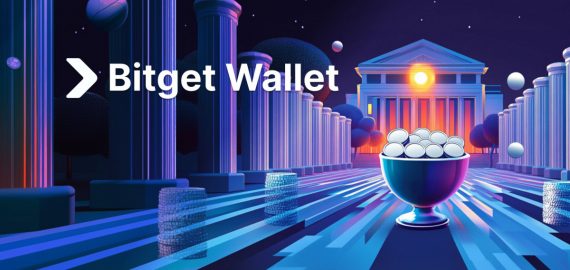The Web3 Gateway Billions Already Use: Telegram’s Real Potential Explained


In Brief
Telegram is becoming the most adopted Web3 platform, combining native wallets, Mini Apps, and the TON blockchain inside a messenger used by over a billion people — creating real-world use cases for crypto at scale.

Telegram has transformed into a major gateway for blockchain interaction—anchored entirely in its own infrastructure. On March 19, 2025, Pavel Durov officially announced on X that Telegram reached 1 billion monthly active users amid its growing Web3 integration.
The integration with TON deepened in early 2025. Telegram confirmed that all Mini Apps now run exclusively on TON, with TON Connect serving as the only wallet integration protocol.
Official TON stats show that by June 24, 2025, the blockchain network recorded 44.8 million on-chain activated wallets (daily average of ~107,700 active wallets), processing over 1.6 million transactions per day, per TONStat’s on-chain dashboard. This level of integration enables Telegram users to access decentralized games, tokenized chats, and peer-to-peer value transfers—all without leaving the app.
These figures come directly from Telegram founder communications and TON’s official network dashboards. They make Telegram one of the most significant platforms for mainstream Web3 adoption in 2025.
The Backbone — TON Blockchain and Native Wallets
Telegram’s Web3 capabilities rest on TON (The Open Network), a high-performance, Layer‑1 blockchain originally developed by Telegram before transitioning to the TON Foundation. As of April 30, 2025, the network runs its latest protocol version, and core development is overseen by the TON Foundation and community contributors.
TON is designed for fast, low-cost transactions. Its multi-chain, dynamically sharded model can scale to millions of transactions per second . On-chain metrics confirm this performance: average block times range from 2 to 5 seconds, with finality under 6 seconds. Transaction fees typically remain under $0.01, making micropayments feasible for broad audiences.
In September 2023, Telegram released TON Space, a built-in, self-custodial wallet within the app. Users can create wallets, store and transfer Toncoin and other assets, and interact with dApps without leaving Telegram. TON Space supports cross-shard transactions seamlessly and allows fee payments via Telegram Stars, immediately lowering barriers for users unfamiliar with crypto tools.
By mid‑2025, the TON ecosystem had onboarded over 35 million active wallets, setting it apart from many standalone Layer‑1 networks. These wallets are used daily for peer-to-peer transfers, microtransactions, and powering integrated gaming and DeFi applications inside Telegram.
Telegram offers a true Web3 experience by embedding blockchain tools directly into the app—no extra platforms, no extensions, just seamless interaction where users already chat and transact.
Web3 Use Cases on Telegram — From Gaming to DeFi
Telegram’s move into Web3 goes beyond ideas. It’s driven by active, in-production applications embedded directly within chats. These apps leverage Telegram’s unique user base to offer fully on-chain experiences, from gaming to finance, without leaving the app.
The TON Foundation reports that simple “tap-to-earn” games have brought over a million users into Web3 via Telegram Mini Apps, creating a gateway effect for deeper participation.
Notcoin represents a high-water mark in gaming adoption on TON. According to the TON ecosystem blog, it reached 20 million users within weeks of its January 2024 launch — driven entirely by organic viral spread .
Hamster Kombat stands as one of the fastest-growing GameFi experiences. Directed by an anonymous core team, it amassed more than 300 million registrations by mid‑2024. Its reach has been so wide that Iranian authorities have taken notice, underscoring its global scale.
Beyond games, Telegram has become a foundation for Web3-native financial tools:
- Decentralized exchanges and trading bots operate entirely within chat windows, enabling peer-to-peer swaps.
- Mini App wallets support yield generation and token transfers without users ever opening an external browser.
- Embedded DeFi protocols allow staking, lending, and liquidity provision via Telegram interfaces.
By integrating DeFi and GameFi within the platform, Telegram aligns blockchain capabilities with natural user behavior — messaging, gaming, and payments — inside a single interface. This practical integration is the clearest signal yet that Telegram is emerging as a primary gateway into the decentralized web.
Scale & Metrics — Is Telegram’s Web3 Promise Real?
Telegram has quickly become the most accessible on-ramp to Web3. Verified data from TONStat confirms real traction:
- ~1.76 million monthly active wallets: users interact with blockchain services via Telegram on-chain at least once a month.
- ~107,700 daily active wallets: a strong daily engagement level among a large user base.
- ~1.69 million transactions per day: TON processes nearly two million on-chain operations daily.
These metrics illustrate active usage—moving beyond early experimentation. Wallets and transactions are not theoretical: they represent ongoing user interaction with TON via Telegram.
Additionally, TONStat reports 28.45 million jetton wallets and 23.35 million NFTs issued, indicating that digital assets are being adopted at scale. The 67.5 million TON locked in liquid staking further signals deeper ecosystem engagement.
Importantly, adoption is driven by peer-to-peer distribution. Communities, creators, and influencers are embedding Web3 use directly into chat operations. Users don’t launch separate apps—they encounter crypto-native services within their social interactions.
Telegram has effectively answered long-standing Web3 challenges:
- It delivers blockchain tools at the point of social activity;
- Onboarding occurs with a single tap—no separate downloads or complex setups;
- Everyday conversations become potential gateways to financial ownership.
This is not just a theoretical model. Telegram already functions as a real Web3 platform, with active user adoption and integrated blockchain features. Pavel Durov said on X:
Telegram Web3: Risks & Limitations
Telegram’s integration with TON brings Web3 into everyday chat use—but also exposes new vulnerabilities and user safety concerns that must be addressed.
Phishing via transaction comments
TON’s official security guide warns users that scammers exploit the ability to add comments to transactions. These comments can hide malicious prompts, leading users to unknowingly approve harmful transfers.
Unvetted Mini Apps
Mini Apps operate without mandatory review by Telegram or TON. While this allows fast deployment, it also means malicious bots or contracts may be presented as legitimate. Developers are guided to follow best security practices, but there’s no centralized app vetting yet.
Regulatory and compliance gaps
TON Space wallets are self-custodial and anonymous, which supports privacy but raises concerns in KYC-driven jurisdictions. The TON Foundation manages governance, yet no compliance flow for markets like the EU or U.S. has been officially introduced.
No centralized contract vetting
Smart contracts and Mini Apps aren’t pre-approved by Telegram or TON. While TON encourages secure development and audits, users are effectively self-reliant in assessing safety before using any Mini App.
2025 Outlook — What’s Next for Telegram?
Telegram’s pivot to Web3 isn’t a side project. It’s becoming the core of the platform’s next phase. The foundation has been laid — now comes expansion.
What we can expect next:
- Deeper wallet integration into user flows — including in P2P payments, tipping, and subscriptions;
- New token-based creator tools that let influencers issue coins or NFTs inside their channels;
- More complex Mini Apps for gaming, finance, identity, and social networking;
- Fiat on-ramps and off-ramps integrated directly in-app.
Pavel Durov recently announced on X that Telegram will roll out native AI assistants powered by Grok and Toncoin payments later in 2025, underscoring greater platform automation and deeper token-based utility:
Telegram also has an advantage over legacy platforms like Meta or WeChat:
- It remains independent and focused on privacy;
- It embraces crypto rather than competing with it;
- It has global reach, with particularly high adoption in key growth markets like Asia, Eastern Europe, and LatAm.
Competition will intensify. Other messengers and superapps will try to catch up. But Telegram’s head start — especially in Mini App UX and TON integration — gives it a defensible lead.
If Telegram can scale its ecosystem while preserving user safety and simplicity, it may not just be the most used Web3 platform — it could become the default one.
Disclaimer
In line with the Trust Project guidelines, please note that the information provided on this page is not intended to be and should not be interpreted as legal, tax, investment, financial, or any other form of advice. It is important to only invest what you can afford to lose and to seek independent financial advice if you have any doubts. For further information, we suggest referring to the terms and conditions as well as the help and support pages provided by the issuer or advertiser. MetaversePost is committed to accurate, unbiased reporting, but market conditions are subject to change without notice.
About The Author
Victoria is a writer on a variety of technology topics including Web3.0, AI and cryptocurrencies. Her extensive experience allows her to write insightful articles for the wider audience.
More articles

Victoria is a writer on a variety of technology topics including Web3.0, AI and cryptocurrencies. Her extensive experience allows her to write insightful articles for the wider audience.

















































